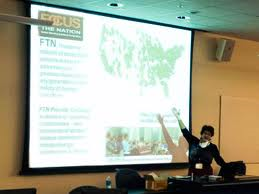This is a summary of the first #eltchat on Wednesday 23rd October, 2013. There were relatively few participants and the chat was slow to get started, mainly due to technical difficulties with Tweetdeck, but, nevertheless, some good ideas were shared.
Management versus leadership
The similarities and differences between these two roles is an age-old debate and @touqo wondered if it had any resonance with classroom management. It was generally agreed that it did. @Marisa_C said that she often asks teachers to think of the qualities of a good CEO or leader and ask what can be learned from them. The teacher as a leader can set a good example for students, particularly for teens who like to have their 'idols'. Good leaders brief, support, monitor, encourage, reward, listen, intervene when necessary - these are all good classroom management skills.
Is classroom management the same for different age groups?
This question was posed by @OUPELTGlobal. Participants felt that the basic principles are the same across all age groups, but the methods of implementation need to be adapted. @Marisa_C pointed out that young learners expect a firmer hand from the teacher, whereas older students can contribute to the rules and seek and accept choice. @Shaunwilden argued that some adults prefer a firmer teacher. This has certainly been my experience, especially with students who haven't been in a classroom for a number of years.
The first days of a course
The beginning of any course is the time to establish good classroom management. Contracts between teachers and students are a good idea so that everyone knows what to expect. It's important to give students as much input into the content of these contracts as possible. The contract should be displayed on the classroom wall throughout the course as a reminder and as a way to reinforce good behaviour.
Goal setting is equally important so that students know what they should achieve, in every lesson and over the course as a whole.
The first ten minutes of a lesson
There was a consensus that the first ten minutes of any lesson are crucial in good classroom management. This is the time when we set the tone and motivate our students to learn. Personally, I try to make sure that I am in class before the students arrive. That way, I invite them into the class and make sure they are speaking English from the moment they enter the room. With young learners I use a 'password system' whereby students have to say a word or answer a question from the previous class as they come in. As @OUPELTGlobal said, this all helps students to make the transition to English from their L1. For the same reason, @cathmmadrid nearly always begins her lesson with a game which recycles vocabulary from the last lesson.
During the lesson
Seating is important, both in terms of the arrangement of the chairs and also where particular students sit. It was agreed that students should move around as much as possible during a class.
@OUPELTGlobal suggested using a 'traffic light' system to reduce the use of L1 in class.
I gave the example of one of the best teachers I have ever worked with. She had her classroom management during the lesson down to a series of small gestures and facial expressions. It was a joy to watch! She achieved this through establishing the rules at the beginning of every course and being consistent. Students knew exactly what was expected of them and, as a result, teacher talk time concerning classroom management was minimal. I regularly used this teacher as a role model for her colleagues and tried to role out her techniques across the whole department in order to create consistency - something which we all agreed is crucial to good classroom management.
The end of the lesson
Just as it is important to start well, it's vital to end the lesson on a high. @touqo gave us the analogy of a rock band who start a concert with their second-best song to get the audience motivated and save their best until last to make people want to come back for more! Students must leave the class with a real sense of what they have learned during it.
How much does good classroom management affect students' performance and results?
 It was agreed that good classroom management is a major factor - good students' results can suffer if they are in a poorly managed class and, conversely, weak students can thrive in a well-managed environment. Good classroom management inspires student confidence in the teacher and sets boundaries on how the learning happens. Bad classroom management takes up all the classroom time.
It was agreed that good classroom management is a major factor - good students' results can suffer if they are in a poorly managed class and, conversely, weak students can thrive in a well-managed environment. Good classroom management inspires student confidence in the teacher and sets boundaries on how the learning happens. Bad classroom management takes up all the classroom time.Teachers often don't give classroom management the importance it deserves. @Shaunwilden reported that he sees this on diploma courses all the time - teachers think they know it, but then often do it appallingly. Classroom management techniques evolve over our careers as teachers and it is something we always need to keep in mind when lesson and course planning.
Conclusion
@Marisa_C summed up the chat very nicely by saying that good classroom management is not just about control and discipline, but also about engagement and motivation.
Links
- The flip side of good classroom management by @Marisa_C
- Classroom Management Techniques by Jim Scrivener - review by @ELTExperiences



















